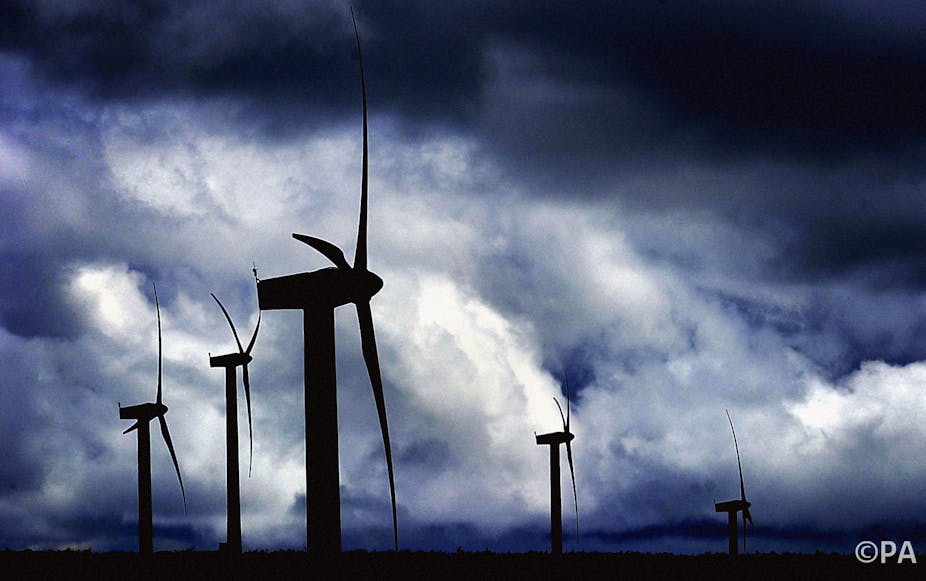The Conservative Party apparently plans to introduce a moratorium on future onshore wind farms from 2020, hanging their hat on the growth of offshore wind instead, and following Germany’s lead by expanding solar power.
The Royal Academy of Engineering this month completed a study into wind energy which compared estimates for capacity growth for onshore and offshore wind, and estimates of cost. The reported findings are that Britain will have around 13GW of onshore wind by 2020, rising to 22GW by 2030.
As onshore wind is expected to cost around £90 per megawatt-hour and offshore wind £140, ending the possibility of further onshore developments could be expected to add at least £1 billion per year to consumer electricity bills by 2030. Whether voters think it will be worth paying perhaps an extra £50 per year per household to avoid onshore wind farms is not a question engineers can answer.
This hardly tallies with the prime minister’s claim upon the coalition taking power in 2010, to want to be the “greenest government ever”, something he described as “a very simple ambition and one that I’m absolutely committed to achieving”. There must surely be doubts that he understood the magnitude of the commitment.
Nicholas Stern’s review in 2006 identified the costs of ignoring climate change and described it as a case of market failure. Initially British politicians responded to the threat of climate change by adopting very demanding targets for CO2 reduction – but for well into the future, by which time all serving politicians would have retired.
When the bill that became the Climate Change Act 2008 was laid before parliament, the target was for a 60% reduction in CO2 emissions by 2050. A few weeks before the final reading, the IPCC Fourth Assessment Report recommended an 80% reduction, and this was adopted by the Labour government, but with negligible debate over whether it was achievable.
Some light was shed on achievability by another report in 2010. The Royal Academy of Engineering study analysed the options for attaining that 2050 target and concluded: “Turning the theoretical emissions reduction targets into reality will require more than political will: it will require nothing short of the biggest peacetime programme of change ever seen in the UK.”
In the past four years, it has been difficult to identify either the political will, or the public acceptance of the likely implications – or indeed any great programme of change.
The UK has some of the best wind resources in Europe, and besides the decarbonisation benefits that wind energy would offer, onshore wind is a fairly substantial industry, supporting (in 2011) more than 8,600 jobs and contributing more than £500m to the UK economy. With continued growth, by 2020 that could total 11,600 direct and supply chain jobs. The Tories’ mooted policy change would put that growth at risk.
Swap for solar?
The government’s plan to increase the amount of solar power to 20GW by 2023, concentrated on small and medium installations – such as on the roofs of schools, hospitals and government buildings, could be an even greater challenge. These would feed into the distribution system (the consumer end) rather than into the high-voltage grid (the power generation end), as would conventional power stations or “agricultural-scale” solar farms.
The load on the electricity system on a bright summer morning can be as low as 25GW, which could be completely provided by solar panels and wind turbines. Maintaining stability of the grid relies on having large power stations which renewables can lock onto. Moving to a situation where, at certain times of the year, the load could be supplied entirely by renewables would require a complete rethinking of the way the electricity system is controlled.
This would be possible, but it would be very different from what we have at present, and it is not something that can be introduced in five years on the basis of a few ministerial statements.
We also have to remember that the peak demand for electricity is early evenings in December, at which point solar panels would provide next to nothing. Nuclear power stations would be needed, but given the economics of nuclear power and the long time required to start up or shut down a power station, how these could be integrated into a national power supply largely driven by solar power and offshore wind is not simple. In fact it is more than “not simple”; it is a system that has yet to be achieved anywhere in the world.
It’s easy to be critical of the analysis that has (or may not have) gone into the evolution of present energy policies, but this is part of a long term trend. Over the past 40 years we have seen energy policy switching between leaning heavily towards nuclear power (1970s and 80s), through a “dash for gas” (1990s), a nuclear-free, renewables-only policy (2000s), back to nuclear (under the coalition, leading to Hinkley Point C), and now swinging again between wind and solar.
In 1974, Lord Carrington was secretary of state for energy. Since then, responsibility for energy policy has passed through the hands of 20 secretaries of state. During 2013, the largest proportion of electricity (41%) was from coal-fired power stations, all of which were of sufficient vintage to have been operating in Carrington’s era.
Energy infrastructure has an investment horizon of at least 40 years. This, and the decisions that must be made to bring about investment, is incompatible with energy policy that can be reversed every couple of years.
Energy policy is simply too important to be left to short-term political expediency. If we are to meet the trilemma of affordability, sustainability and security, we will need carefully considered plans that, with cross-party support, will outlast at least a dozen energy ministers.

